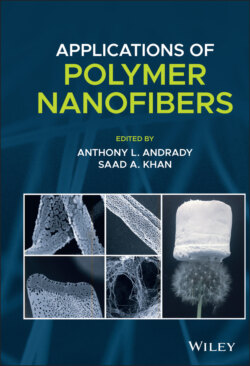Читать книгу Applications of Polymer Nanofibers - Группа авторов - Страница 34
2.1 Introduction of Nanofibers in Textile Applications
ОглавлениеTextiles are defined as materials consisting of aggregate structure of natural or artificial fibers (Wong et al. 2007). As a conventional industry, textiles originated from ancient times and the initial purpose was to shield bodies and keep them warm. Whereafter, with the exploration of new fibers and new fabrication techniques, the textile industry started to boom and became mature. However, in order to catch up with the trends of high technology and obtain higher profits and competitiveness, new techniques are extremely in high demand for this traditional industry.
Nanotechnology, currently a quite attractive and promising technology, has become a gold rush in a significant number of textile applications in terms of filtrations, fiber composites, medical textiles, protective clothing, smart garments, etc. (Wong et al. 2007; Feng 2017). It is also practical in functional finishing of fabrics, such as flame‐resistance, anti‐static, antimicrobial properties, and so on, mostly modified by additive nanoparticles (Zhou and Gong 2008; Vitchuli et al. 2010). Additionally, nanotechnology plays a pivotal role in the fabrication of new textile materials to form nonwoven and woven fabrics from nanofibers or nanofiber yarns, in order to obtain some unique functions (e.g. high specific surface area, high porosity).
The diameters of traditional fibers are usually greater than 2 μm. It is important to note that fibers in a smaller size (particular in nanosize, with a diameter less than 500 nm) can bring fantastic features, such as super‐hydrophobicity, excellent flexibility, good electrical property. For instance, Matsumoto et al. found that chitosan/polyethylene oxide nanofiber fabrics provided great electrostatic force, which could contribute to DNA adsorption for biomedical use (Matsumoto et al. 2007). The small size and large porosity of nanofiber nonwoven fabrics were also in favor of capturing PM 2.5 particles (Wang et al. 2016). According to literature, nanofibers can be produced maturely by a variety of techniques such as electrospinning, melt blowing, bicomponent spinning, and flash spinning (Feng 2017; Zhou and Gong 2008). However, it is still in the exploring period to fabricate the nanofiber‐based yarns and fabrics.
This chapter includes the cutting‐edge fabrication methods of nanofibers, nanofiber‐based yarns, and fabrics. Nanosized textile materials are able to provide greater advantages than traditional textile materials, such as smaller pore size and larger surface area. Due to these unique properties, nanofiber‐based woven/nonwoven fabrics have created a variety advanced fields of applications. Here gives an overall vision of their technological processes, mostly in the laboratory stage, to discuss the current research status and bottleneck problems.
